#Moto Theme
Explore tagged Tumblr posts
Text


#aesthetic#photography#cute#photography aesthetic#alıntı#my post#türk postları#türkiye#tumblr türkiye#motorbike#motorcycle#moto love#motorsiklet#black photographers#black tumblr#black#black and beautiful#baby posting#baby cute#cute pictures#princess#white theme#soluksaripapatya#solukmavipapatya#sarhoskedi#kafaminguzelligi#kesfet#keşfet#alintilarim#harleydavidson
172 notes
·
View notes
Text
HELLO DO YOU WANT MORE ART?!
With the release of Stage in Playful Land today....allow me to show you something I've been working on for the past year! I promise I will cover this story in And You Though Things Were Over but do give me time to play through the event and draft my version.
*clears throat to mimic Fellow*
Gentlemen welcome! We have the finest selection of puppets for you to choose from! Do any of them catch your fancy?






#yugioh#twisted wonderland#and you thought things were over#yuma tsukumo#judai yuki#yusei fudo#yugi moto#yusaku fujiki#yuya sakaki#stage in playful land#i had major hyper focus on these for some reason#i just like creepy dolls#yuya is the ssr for this one#because he would be the focus in a circus themed event#in this house ernesto doesn't exist#he is fellow honest
64 notes
·
View notes
Text


FABIO -- Red Bull Grand Prix of the Americas 2023
#LITTLE SPIDERMAN THEMED WHORE!!!!!!!!!!#moto gp#fabio quartararo#motoedit#kyle.gif#fabioquartararoedit
284 notes
·
View notes
Text
Megadeth - Moto Psycho
#Megadeth#The World Needs A Hero#Full-length#Release date:#May 15th#2001#Genre:#Thrash Metal (early/later); Heavy Metal/Rock (mid)#Themes:#Society#Politics#History#Death#Religion#New World Order#Addiction#Love#USA#Moto Psycho
6 notes
·
View notes
Note
Since you still talk about Chains of Heart, I hope you're the right person to complain to, because: Why hasn't Haii Sarunsathorn been in more things?! That man should've been in at least 2 shows between TT2 and COH and he should have at least 3 projects lined up! I looked up the main cast on MyDramaList and everyone (deservedly so) has at least 1 future project lined up... except for him. I hope this is a choice on his part and nobody is actually stupid enough not to cast him in more things.
An ask about Haii my beloved? 😱 Yes, you've come to the right place! On this blog we cherish Haii and everything CoH-related. 🙏
But yeah. I don't get it either. I mean, look at him:

He's one of the most beautiful people I've ever seen. He can act. He can cry on command. He can do physical roles. He can do sensual roles. He likes motorcycles (v important!!), and by all accounts he seems to be a lovely person all around.
What is wrong with you, Thailand?? It is an outrage!
The only explanation(s) I have is that he's doing acting for the fun of it (like so many Thai BL actors do) and that he has a different career to fall back on. Or maybe he lacks business connections (then again, he seems to be ig mutuals with a lot of other actors). Or - which sadly is a real possibility - they don't know how to cast him because he's not really fitting the Series Y stereotypes of a typical seme/uke.
Personally, I'm hoping that Mame's The Boy Next World (which is a super intriguing novel that would work so well as a series) is still happening and that he'll still be Cir. 🙏
Or maybe Harikarn - which he and Chaaim (Phayu in CoH) seem to be working with - will produce a new series eventually.
#ask#chains of heart#haii sarunsathorn#chains of heart the series#jane watches stuff#someone should do a moto racing themed bl and cast him as the lead
8 notes
·
View notes
Text
yes i am excited for season 4 of succession but i am equally as excited for nicholas britell’s SCORE for season 4 of succession
#wish i could recapture the feeling of hearing andante agitato for the first time#like…thinking it’s a reprise of andante con moto…and then it just goes absolutely NUTS and then the CREDITS with the main theme reprise MAN#so excited to hear what motifs s4 will bring#because s3’s score was a lot more energetic and focused on strings > piano which was very fittingly baroque#so i wonder how the themes of s4 will be reflected in the score goddddd#can you tell i started this show because of the main theme#nicholas britell#succession#maya.txt
8 notes
·
View notes
Text
Western literature & shoujo manga.
If you're, like me, someone whose passion is old shoujo manga, you may have noticed that at least one or more of your favorite mangaka has written manga adaptations of famous American and European novels. But why ?
According to this essay by Kawabata Ariko and Murakami Riko, in the early 20th century, because there was no Internet, people had no choice but to rely on big bookstores to learn more about and to purchase foreign novels. It was therefore not common to read them. The Iena bookstore, located in Ginza, was a rare indie bookstore that sold art-related foreign books and, while unfortunately, the store has closed today, many shoujo mangaka remember going there often to look for reference material amongst foreign works.
This other essay by Oogushi Hisayo states that foreign novels were only broadly introduced in Japan for young girls in the 30s. Famous girls' magazines (which are to be differentiated with shoujo magazines) such as Shoujokai (created in 1902), Shoujo no Sekai (created in 1906) and Shoujo no Tomo (created in 1908) started introducing Western literature in their issues from the 1930s to the 1940s. Works such as "The Little Princess", "Heidi", "Little Women", "Daddy Long Legs" and more were published in these girls' magazines, making them more known to the Japanese audience and resulting in shoujo manga adaptations in the following years.

Little Women illustrated by Nakahara Junichi in the Girls' magazine Shoujo no Sekai.
Three works in particular seem to have gained a lot of popularity in the 40s: "Little Women" by Louisa May Alcott, "Heidi" by Johanna Spyri and "Anne of Green Gables" by Lucy Maud Montgomery. All three are coming of age stories of young girls, and all three have one theme that seems to stand out: family. In the aftermath of WW2, many Japanese lost their families and many young children became orphans. In such times, novels that showcased happy families comforted Japanese readers. The popularity of these three works did not end in the 40s though, since in the 70s and 80s, all three got their 50 episodes anime adaptation in the Calpis Gekijou series (also known as World Masterpiece Theater), which, by the way, I highly recommend watching.
It is to be noted that these three works also became popular because they showcased independent and developed female leads, which has since then become a staple of shoujo manga itself, regardless of genre.


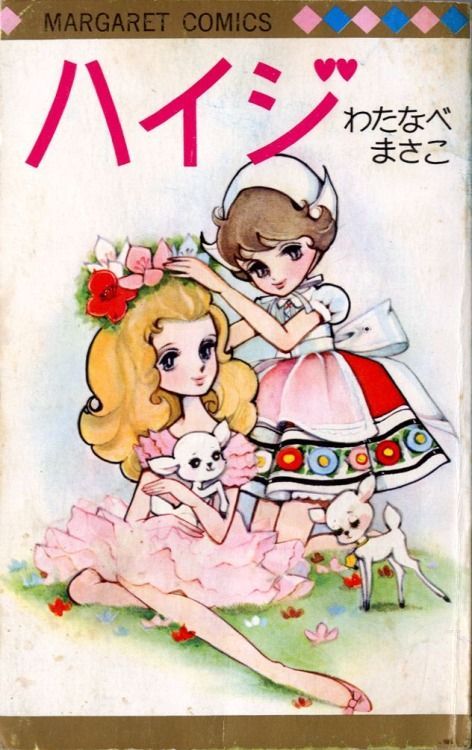
Heidi by Macoto Takahashi, Anne of Green Gables by Sakamoto Midori (1977) and Heidi by Watanabe Masako (1966).
In the 70s, a few mangaka published works that reminded critics of the "Bildungsroman". The Bildungsroman is a literary genre born in the 1800s in Germany, and it is a sub-category of the coming-of-age story. The Bildungsroman stands out from regular coming-of-age stories by focusing on the psychological and moral growth of its protagonist. Examples of that would be Moto Hagio with The Heart of Thomas in 1974 and Takemiya Keiko with Kaze to Ki no Uta in 1976 (though she never intended to write a Bildungsroman). The West was still shown in a more traditional version in these works, as both stories take place in old catholic boarding schools.
Similarly to how Audrey Hepburn, a Hollywood actress, was seen as a fashion leader in Japan (more about that on my other post about her influence on shoujo), Japanese people at the time had an idealized view of the West and anything from the Western world seemed fashionable and trendy. A great example of that is Sanrio. If you look at early Sanrio characters, a lot of them are from the West: Hello Kitty is British, the Little Twin Stars were inspired by Christmas, My Melody by the little red riding hood, Jimmy & Patty are American etc.
This view of the West began to shift in the 80s and the western literature that inspired shoujo mangaka started to change as well. Instead of comforting, idyllic stories about family life in a traditional American or European country side or stories taking place in traditional European catholic schools, manga inspired by more realistic and contemporary works started publishing. For example, Banana Fish by Akimi Yoshida (1985) draws inspiration from "A Perfect Day for Bananafish" by J.D. Salinger and two of Hemingway's works: "The Snows of Kilimanjaro" and "Islands in the Streams". All three of these focus on either modern issues like overconsumption or darker themes like death and loneliness. The change can also be seen in the gender and age of the protagonists. Instead of being about young teen girls that shoujo readers could identify with, Banana Fish is about adult men. The inspiration is also a lot more loose, and instead of an adaptation, there are only references to J.D. Salinger and Hemingway's works throughout the manga.
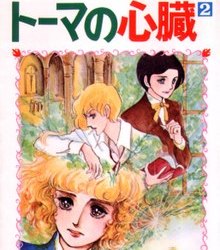


The Heart of Thomas by Moto Hagio (1974), Banana Fish by Akimi Yoshida (1985) and Alice in Wonderland by Mutsu A-ko (1983).
To conclude my post, I really wanted to include this line from the essay by Oogushi Hisayo: If America (can apply to the West as a whole) was once the backdrop of stories for those who yearned to read about "somewhere that is not here", it has, from the 80s onward, become the backdrop of stories for those who yearned to read about "the now and here".
#shoujo history#shoujo#vintage shoujo#retro shoujo#60s manga#70s manga#80s manga#nakahara junichi#watanabe masako#takahashi macoto#heidi#anne of green gables#little women#the little princess#vintage manga#setsuko tamura#banana fish#akimi yoshida#40s#manga history#shoujo manga#moto hagio#keiko takemiya
307 notes
·
View notes
Text

Mastemon Ace EX6-029 by Takeuchi Moto from EX-06 Theme Booster Infernal Ascension
#digimon#digimon tcg#digimon card game#digica#デジカ#digisafe#Mastemon#ace digimon#Takeuchi Moto#EX6#digimon card#color: yellow#color: purple#type: vaccine#trait: angel#Lv6#num: 03#jogress
178 notes
·
View notes
Text

What if they kissed in astronomy tower huh ??? more jimcurly hogwarts au rawrarwr
btw mine music theme for them in that au is "Keep your dearkness secret" by Moto boy👊👊👊
122 notes
·
View notes
Text
An essay on the theme of children-parent relationships in Hagio Moto's works by Murakami Tomohiko
For years, I avoided reading the essays that were included at the end of bunkoban volumes. Reading Japanese prose felt like a chore to me, to be honest. A too high of a hurdle. And most of the time, the contents went over my head.
That being said, since I started reading them, I've come across some pretty interesting ones. The analysis written by Murakami Tomohiko, manga critic, at the end of Mesh's vol. 3 (Hakusensha Bunko, 1994) was particularly interesting for me. So, I tried my hand at translating butchering it. The author compares the boys in Hagio's manga and their family issues. You can find it below the cut.
If anyone wants to read the original, I can send pics/scans!
Province of children
Murakami Tomohiko (Manga critic)
For a child, what does it feel like to be neglected by their parents?
Mesh is the protagonist of this story. His mother, elopes with a man when he was young. His father, doubting whether he’s Mesh’s real father or not, drives him away from himself, and places him in a boarding school in the faraway Switzerland. For 12 years of his life, he believes that his mother abandoned him, and his father hates him. It’s not hard to imagine how deep the scars such feelings left in Mesh’s heart are.
Mesh’s mother gave him a girl’s name, “Françoise-Marie.” We do not know if she wanted to have a daughter that bad, but as Mesh was separated from his mother when he was 2, he never knew the truth. But how much of a deciding factor that name became for him, and how it kept bearing heavy on him in his later years, are beyond any doubt.
When Mesh was 12, silver locks started to appear on both sides of his blond hair. After seeing a proof of genetics at work, his father finally recognized him as his own son. But that wasn’t the salvation the he was looking for. When his father shifted the blame on Mesh’s mother’s licentious behavior for doubting his paternity, a new wound was opened on the young boy's heart.
“I won’t say that my mother was a saint. But for a child who lives in a dormitory... a mother something that he needs.”
Thus, in chapter 1, "Mesh,” our protagonist runs away from his paternal home. He is picked up from the streets of Paris by Millon, a young art forger. In the final chapter, “Sure Love and Real Death,” he is reunited with his mother, now living in her homeland of Lorraine. She is mentally instable and still running after the image of her "daughter" who never existed. Mesh is an abandoned child who hates his father so much that he wants to kill him, and who is struggling to break free from her mother’s chains. This manga chronicles his story of breaking free from his parents.
Children discarded by their parents. Children separated from their parents. Such children fumbling their way in their quest to find their personal salvation had been recurring motif in Hagio Moto’s works before Mesh. It is also is the principal theme of this work.
If we look back, in "Bianca (ビアンカ)," she drew a girl who danced away the stress the divorce of her parents caused in a forest. In “Girl on Porch with Puppy (ポーチで少女が小犬と),” she shows us another girl who sees the world through rose-colored glasses. Grown-ups who lost their dreams point their fingers at her, and shoot her with death rays. Or take Emil Bruckhardt from “Snow Child (雪の子).” He was taken in by his grandfather after his parents’ death, who anly accepted for taking the child in if it was a "boy." 12 years of Emil's life was spent by his side, pretending to be a boy. Young Tim from “Poor Mama (かわいそうなママ)” pushes his mother out of the window. He could no longer bear witnessing her misery, as she spent her days sitting at the window sill, gazing off in the distance, and sighing. The free-spirited and brave Eru of the Nobe family in “Red-haired Cousin (赤ッ毛のいとこ)" shows no sign that would make you think that she is an orphan.
They were all children torn apart from their parents.They had to find somewhere to belong, and find it themselves.
The Poe Clan has two boys who were taken away from their biological human parents and turned into vampires, destined to live until eternity. If we think about under the same light, we can say it's their story of trying their hardest to create a pseudo-family for themselves time and time again on their endless journey. The beautiful Poe instalment, "Birds’ Nest (小鳥の巣)," and works like "Heart of Thoma (トーマの心臓)" that followed it, all take place in worlds that have nothing but boys torn apart from their families. It is no coincidence that dormitories were chosen as their settings.
Mesh was published in Shogakukan’s Petit Flower magazine between the 1980 summer issue and 1984 June issue. Mesh was preceded by "The Visitor (訪問者)" in the 1980 Spring issue.
In "The Visitor," we follow a central character from "The Heart of Thomas," Oskar Reiser, during his childhood, before he starts to live at the dormitory. Its main theme is directly connected to that of Mesh. Young Oskar’s parents quarrel over his birth. One day, a single gunshot steals that little boy’s mother from him forever. The one who fired the shot was his father. The boy covers up for his father, and the two set out on journey with no destination. However, Oskar’s father leaves him at the school, of which the principal is an old friend of his and Oskar's real father, and leaves for Southern America alone.
Oskar kept yearning for his father, the father who stole his mother away from him, without begrudging him. He did so, because he had nothing else in life to cling onto. As his father and mother argued about his paternity, the child lost that household as the place he belonged. Young Oskar’s only wish was to be forgiven by his parents, and to believe that he would be acknowledged as the son of that family. To make his wish come true, to beg for his father’s forgiveness, Oskar covers up for his father, the murderer of his mother, and sticks even closer to him.
Our protagonist Mesh is a direct continuation of the image of boyhood we see in "The Visitor"s Oskar Reiser. This link continues until Hagio’s current serialization, "A Cruel God Reigns", and shapes the main plot of her stories. “Children abandoned by their parents” has been present as a principal theme since Hagio Moto's early works. The turning point which made this theme even deeper, might be just this period that connects "The Visitor" to "Mesh."
How did Mesh rationalize his mother giving him a girl’s name? He mostly introduces himself using his alias, “Mesh,” to new acquaintances, and he is very adamant about it. Those who are unaware of the circumstances are left perplexed by that name, and mistake Mesh for a girl. He seems to find that amusing deep down. He crossdresses and appears on stage, and he is approached by homosexual men. Both makes him feel uncomfortable. Yet, he doesn’t seem to have a the willpower to resist.
Actually, I have also experienced something similar. So I believe I understand how Mesh feels a little.
When I was roughly Mesh’s age, I was a child who liked to act like a girl. In high school, I put a tablecloth on my desk in class, made flower arrangements with artificial flowers in an empty wine bottle instead of a proper vase, and listened to lectures while holding a stuffed doll. Mine was quite a free-minded school, and it was an age when all kinds of rebellious acts were "in." But still, when I think back upon it, what I did seems outrageous to me. Maybe I was just too eccentric, which is why my teachers never said anything to me.
I was jealous of my mother’s colorful outfits. I often borrowed and wore them. Her sleek green trench coat and tank top with pink and white borders from Kamoi Youko’s underwear brand, Tunic, were my favorites. I once even made a dress for myself. I chose the fabric with my girlfriend, did the basting at her place, and she sewed it for me. She tagged along because she found it to be fun, but I’m certain that she was weirded out.
I am still a sucker for stationary and fancy items girls would like. If I go to Sony Plaza or American Pharmacy, I am confident that I can spend half a day there. There aren’t many fathers who would go to buy picture books and plushies for their kid, but get carried out and just buy whatever they want.
Putting it like that makes me sound like a man with perverse hobbies, but sadly, I am not such inclined. I have never felt attracted to men, and never have I ever wanted to be a woman. My interest in crossdressing had something different in it. But I am interested in feminine, rather, “girlish” things, but it only means that I am slightly different than your average, common man.
That being said, my mother’s influence on me cannot be ignored. When I finished my dress, it was her who was the happiest and told me to wear it and take a little tour outside. During my freshman year in university, she was the one who lamented the most when I cut my hair that was reaching my butt, and made a hairpiece with my hair for me. When I was in grade school, I once trimmed my eyelashes with a pair of scissors because they were getting in the way when I was using the microscope. I remember her being frustrated to the point of bursting into tears, and getting so angry with me.
I believe it was my mother who slowly created my very particular aesthetic sense by praising things like long eyelashes, lustrous, straight hair, a slender physique which becomes female school uniforms. All things that would be the charm points of budding young girls, and she did it at every chance. I am an only child, and have no siblings. When I was a child, my mother once asked me if I wanted to have little brothers or sisters. I told her that I would like to have an older brother, which seemed to perplex her. Maybe my mother wanted to have a daughter. She could be looking for the shadow of the daughter she never had in me.
I don’t really know the truth of it. Maybe she just said that I looked like a girl just to express how cute her son was, without putting much thought into it. But the words she said, words I have no recollection of, very likely had a huge impact on me and awakened something deep inside my soul. My personal preferences took shape around that idea, and before I knew it, it seeped into my entire being.
My mother was a beautician, and was often away from home on business. After she opened her own store, she was always busy with work. But that was all there was to it, and it was not like she had left me, or we were separated by death. And it never became a reason for my parents to hurt or to oppress me. I can say that overall, I grew up in a your rather ordinary, warm household. I still started to shape my very own personality, alongside the one my parents took part in creating. Then how about a child who feels hated, or abandoned by his parents? How would he feel? To heal the wounds he got from his parents and to ail himself, would he acknowledge it all, and accept everything? Or would complete denial be his only choice?
That's why Mesh wanted to kill his father and break free from his mother’s curse. While he wanted to be freed from his mother’s desire to have a daughter, in some corner of his mind, he was curious about what would happen if he complied. Maybe that’s what made him stand on the stage as a woman, and occasionally enjoy being photographed as one. Maybe that’s why he sometimes shut up and endured it when men treated him like a girl.
Maybe fulfilling his mother’s wish meant securing a place in her heart for him. It might have been a self-defense mechanism — a feeling that only children abandoned by their parents know. That’s why when he faced her, and saw that his mentally ailing mother would never accept him, a boy, Mesh said: “Just what does Marché want? How can I get close to what she wants? What should I become? Marché’s dreams, and my dreams... If only I knew...”
“A thousand pairs of scissors. Scissors that cut and mince. I could have become a flower, a bird, a daughter... I could have become anything you wanted. I could have died a thousand deaths if you wished for it.”
We do not know the reasons why she wanted to have a daughter. No matter what they might be, accepting them as they are, that complete subordination, is an expression of his willingness to bend to his mother's will. What does it feel like to hear “I hate this child” from a mother who can’t even tell his son apart? But Mesh even accepts his mother trying to stab him with shears without saying a single word.
Where does Mesh’s determination, which is almost commendable, come from? What steeled his resolve so? I think it was something closer to despair, rather than a wish to be delivered. Mesh’s hatred and his murderous thoughts towards his father are the two sides of the same coin. Killing his father, who hated both him and his mother, and accepting death by the hands of the mother who forgot her own son: They are actually one and the same. Thus, the child abandoned by his parents try to erase his ties to them. By resetting everything, he tries to make it as if he never existed.
There is probably just one thing he’s trying to say with his behavior.
"I’m sorry.
"I couldn’t be the child you wanted.
"I couldn’t meet your expectations.
"I’m sorry that I was born..."
In “The Visitor”, in the middle of his endless journey with his father, Oskar says these words time and time again: "I will be a good child. I won’t talk about my mom anymore. I’m sorry." Then he obliges his father by starting to live in a dormitory, and waits for his father to be back from South America. This must have been no different than choosing death for Oskar, a child who wanted to be the son of a warm household.
When he doesn’t resist his mother’s attempt to kill him, something inside of Mesh shattered to pieces. He arrives at Paris train station with his broken hopes as his baggage, and he catches a glimpse of his father boarding a train. His father, who acknowledged him as “his son who shares the same blood as him” without so much as a thought about how that made Mesh feel. All Mesh can do is to stand there, motionless. Even if that's the only place he can come back to now.
All children need a place they belong. A place where they feel they can just “be.” Children do not belong to their parents, or other adults. No one shall undermine their right to self-determination. Mesh shows us how much hardship children have to endure, and the sacrifices they have to make when grown-ups forget this fact.
#村上知彦#murakami tomohiko#tomohiko murakami#hagio moto#moto hagio#萩尾望都#24年組#year 24 group#classic manga#vintage shoujo#retro shoujo#manga analysis#manga essay#heart of thomas#トーマの心臓#メッシェ#mesh#訪問者#visitor
87 notes
·
View notes
Text
A Quick History of BL
As someone who wrote a thesis on this very subject a few years ago, here is the short version of how BL has evolved throughout the years. For the new comers ❤
a minute of silence for the original form of this post that tumblr decied to not save right after I saved it
I am going to go with a chronological approach. Unfortunately, I cannot put everything in one post so if there’s any questions about this or that aspect of the history of BL that you want to know and it’s not talked about here, you are welcome to ask me directly :)
Context and influences - Japan in the 60′s
Before the US forced Japan to open its borders to the outside world in the 1800s, homosexual practices were common place between budist monks, samurais and kabuki actors. During the Edo period (1600s to 1800s) there was a very rich amount of poetry, art, books (such as Nanshoku Okagami (The Great Mirror of Male Love) by Ihara Saikaku) and codes of conduct about how to have a good master/aprentice relationship, kinda like the greeks if you know what I mean. However, with the arrival of western influences, in order to become a more “civilized” country, it was all put in the closet.
Yet, in the 60′s Japan started to pick it up again through literature about young androginous beautiful boys (aka bishounen). On one hand, in 1961, the novel Koibitotachi no Mori (A Lover’s Forest) by Mari Mori was published. It tells the story of a young and beautiful 19 year old worker and a half french half japanese aristocrat, and their tragic romance. On the other hand, Taruho Inagaki wrote Shounen ai no Bigaku (The esthetics of boy-love), an essay on aesthetic eroticism (of which he wrote a lot of). All this was know as Tanbi (lit. aesthetic) literature. It generally refered to literature with implied homosexuality and homoeroticism such as works by Oscar Wilde, Jean Cocteau, etc. And of course, Mori and Inagaki.
In chinese tanbi is read as danmei (term used to refer to BL novels in china today, ie: The Untamed it’s all connected friends).
From the birth of Shonen Ai to Yaoi - 70′s to the late 80′s
Around the beginning of the 70′s, shoujo was being revolutionized by the Year 24 Group, a generation of women manga authors (mangaka) who started to explore new themes. Among them, their interest in tanbi gave birth to a new subgenre: Shounen ai.
Their most known manga were:
Kaze to Ki no Uta (The Ballad of the Wind and Trees) by Keiko Takemiya, and Toma no Shinzo (The Heart of Thomas) by Moto Hagio
Their stories are characterized by having suffering eurpoean bishounen in boarding schools, living an idealized perfect love (meaning passionate) that, despite the tragic end of one of them, lives forever in the other.
As this genre starts getting popular, more and more fans of these stories start making their own self published manga, aka doujinshi, of the genre. It is around this time that the term Yaoi is coined. Meaning “YAma nashi, Ochi nashi, Imi nashi” (no climax, no fall, no meaning). Basically PWP fanfiction, for the most part. Doujinshis could be considered an equivalent of fanfiction in manga form. It is also here that the term Fujoshi (aka Rotten Girl, for liking rotten things) starts being used to refer to women readers of yaoi.
With this rise in popularity come the start of the commercialization of the genre. Which meant the publication of magazines dedicated solely to yaoi/shonen ai/BL. The most popular yaoi manga magazine at the time was June. The common trait of their stories being the therapeutic power of the love between the mains. The traumatized character would heal throught this newfound love.
Most of the stories at this time happened in the West (Europe or the States) as the exploration of these dark themes intertwined with homosexual romance and homoeroticism still feel safer to explore as a foreign concept. One example would be Banana Fish (1985).
Commercialization and Yaoi Ronso - 90′s
As more publishing houses pick the genre up, the term Boys Love is used to include every type of manga about homosexuality made for women.
The increasing amount of BL series sees a changes in its themes:
the start of the “gay for you” trope where one mantains their heterosexuality despite being in a homsexual relationship,
the uke/seme dynamic (mirroring hetero realtionships) also relating to physical appearence (one being more feminine, the other being more masculine),
the use of rape as an act love (sexual violence has always been present but here it becomes a staple),
anal sex as the only type of sex,
older and more masculine men start to appear
they now happen in Japan
Good examples of the presence of these themes in manga are Gravitation (1996) or Yatteranneeze (1995).
However in 1992, Masaki Sato (a gay activist/drag queen) wrote a letter in a small scale feminist magazine attacking yaoi and pointing out how it “represented a kind of misappropriation or distortion of gay life that impacted negatively upon Japanese gay men”. The female readers of yaoi responded, defending the genre as a means to escape gender roles and explore sexual themes that was never meant to represent the realities of gay men. This is know as the Yaoi Ronso (Yaoi Debates).
The debate ended with both sides understanding more of each other, with mangakas starting to include queer views in their works. It also started the academic reasearch of BL.
Yet, it is a debate that has been restarted more than once, as it is still relevant despite the evolution of the genre.
more on this on another post
Globalization and coining of BL - 2000′s
By the beginning of the 2000s BL is being sold all over the world (like all manga), and has become a stable industry. We could say it has finally become it’s own genre.
Some of the most well known manga series, to us (in the west), of the time are:
Junjou Romantica 2002 Koi Suru Boukun 2004 Love Pistols 2004 Haru wo Daiteita 1999
all of these have anime adaptations for the curious ones
We also start seeing short anime adaptations or special episodes of the most popular series, with questionable themes, such as: adoptive father x adoptive son (Papa to Kiss in the Dark 2005), father x son’s friend (Kirepapa 2008), etc...
However the themes remain more or less the same. Junjou Romantica’s love story starts with a non-con sex scene by the older one (masc, seme) to the younger one (more feminine, uke) addressed years later in the manga btw. Koi Suru Boukun’s love story is triggered by aphrodisiacs and rape. They’re still very present in the stories but slowly going away. A mangaka that represents this era could be Natsume Isaku (Candy Color Paradox 2010).
Change is slow in Japan. Even though the voices of LGBT+ people started to be taken into account in the genre it is not until later that we see it reflect in the mangas themselves. However, we can already see the start of this in Doukyusei (Classmates) (2006) by Asumiko Nakamura. Also Kinou Nani Tabeta? (2007) which is actually part of a more mature genre: Seinen.
It is my personal (subjective) theory that the BL of this era was the one that got popular outside of Japan, which is why we see lots of references to the themes, tropes and dynamics of this time in today’s BL series.
The LGBTzation of BL and the rise of webtoons - 2010′s to 2020′s
Slowly but surely LGBT characters and themes enter the scene of BL. Existing simultaneously with the previous tropes and themes, we start seeing a shift in these stories. We now see:
characters that identify as gay or some type of queer
discussions about homophobia
more mature themes about life and romance
At the same time as we get the usual love stories with the usual themes, a new trend starts to take over. And we get simultaneously, cute, sometimes questionable but light love stories:
Love Stage 2010 Ashita wa Docchi da! 2011 Kieta Hatsukoi 2019
More profound stories and darker or more complex themes:
Blue Sky Complex 2013 Saezuru Tori wa Habatakanai 2011 (mafias) Given 2013 (suicide) Hidamari ga Kikoeru 2013 (deafness)
And others that adress the queer experience in a more mature way (which might actually fall into the Seinen genre)
Itoshi no Nekokke 2010 (slice of life, queer characters) Smells like Green Spirit 2011 (two ways to deal with a homphobic society) Strange 2014 (relationships between men) Shimanami Tasogare 2015 (an LGBT group helps a closeted gay) Old Fashioned Cupcake 2019 (you know this one 😉) Bokura no Micro na Shuumatsu 2020 (the end of the world)
As queer stories are explored, BL mangakas and mangakas from other genres start to consider more stories about queer people such as the Josei Genderless Danshi ni Aisaretemasu (My Androgynous Boyfriend) (2018) by Tamekou, or the Shoujo Goukon ni Itarra Onna ga Inakatta Hanashi (The story of when I went to a mixer and there were no women) (2021) by Nana Aokawa.
Still, we can see two realities live side by side. Doukyuusei gets adapted into an impactful animated movie in 2016, meanwhile Banana Fish gets an anime adaptation that keeps the homoeroticism but not the homosexuality.
For those who might be interested. Here are some of the authors that represent the first half of this era, where they start to include newer points of view:
Scarlet Beriko, HAYAKAWA Nojiko, KURAHASHI Tomo, OGERETSU Tanaka, Harada, KII Kanna (Stranger by the Sea), etc...
And authors that while keeping classical themes break the stereotypes in a subtle manner:
CTK, ZAKK, Jyanome, Cocomi, Hidebu Takahashi, SUZUMARU Minta, etc...
Mangakas also no longer stick to one genre only. They explore whichever of them they want, from BL to Seinen to others.
ie: Tamekou,
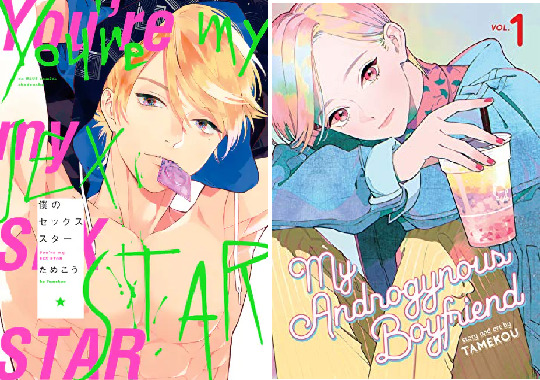
or Asumiko Nakamura

The curious case of Webtoons
With the digitalization of mangas, throught Renta and Lehzin, it has become easier (and more expensive) to access these stories. Korea makes and appearence with their webtoons. Through the lack of piracy protections and the majority of them being digital, manhwa (korean webtoons) sees a rise in popularity. Through the digital medium the influencee can be the influencer.
However, like many other East Asian countries they have consumed BL, without hearing about the conversations about BL. So they end up mantaining the older themes and stereotypes that newer BL is trying to leave behind. Therefore, we end up with a mix of old and new, ie:
Killing Stalking 2016 Cherry Blossoms After Winter 2017 Painter of The Night 2019
Additionally, it is also thanks to the easy access to internet that Omegaverse, with its higher dramatic stakes (that parallel hetero dynamics), enters the mangasphere in 2016. It has grown in popularity ever since.
With the Thai BL Boom of 2020, Japan rediscovers its own BL market and starts investing in it more. Which is why we get live action adaptations of BL manga that was popular years ago (Candy Color Paradox was a manga from 2010), the more recent ones (The End of the World With You) or new anime adaptations (Saezuru Tori wa Habatakanai in 2020).
more on this in my japanese live action BL post
What has it become now? is it BL? ML? or Seinen? Or is it all just gay manga?
It is clear that Shoujo manga (with BL, Josei and Seinen) is exploring queer themes such as gender and sexuality more and more. Japan is interested in this conversation, not only in manga (Genderless fashion). Which brings up the current question in BL studies: Does it make sense to keep these categories?
As a response to BL, ML (Male Love), which is made by gay men for gay men, started happening (around the 70s too). And Bara (gay manga porn) in response to Yaoi. However both gay men and women read BL and ML. We also see other themes being explored through BL, such as friendship (in BL Metamorphose), food (in Kinou Nani Tabeta), male relationships of all kinds (in Strange), and different queer views on life and its challenges (in Shimanami Tasogare). More and more what is LGBT and what is BL is merging, the line is blurred.
Conclusion
BL has been in my life for longer than it hasn't. It is through shoujo and BL that I have come to understand people and romance.
It is flawed, like everything else this life, but it's flourishing in many ways.
The genre feels old and new at the same time.
We can still find shounen ai/tanbi elements in more modern manga (All About J). Or the gay for you in a new light (Itoshi no Nekkoke). Or more educational manga on queer issues (My Brother’s Husband by Gengoroh Tagame). BL has around 50 years of existence but it is also being born anew in Thailand and Korea.
BL manga will continue to evolve in acordance to Japanese tastes, as it is still a local market. Hopefully the korean webtoons that get popular will be the more daring ones in their themes. Who knows where it will go from here? The only thing we know for sure is that it will continue to change. Isn't it exciting?
A post on the evolution of live action BL in Japan is coming, to complement this post. As well as a more detailed explanation of the Yaoi Debates and gay manga.
#history of bl#bl post series#I feel like I left too much stuff out#I hope it makes sense#honestly I would really recommend reading some of those manga#they're super interesting#soon it'll be 20 years since I started reading BL#my gosh#if theres anything anyone wants to know more about#I'd love to write more :)#yaoi manga#bl manga
734 notes
·
View notes
Text
Thanks (mostly) to edits I’ve seen on TikTok, these are now songs I permanently associate with different members of the Bad Batch (this list is super long and also random and unhinged you have been warned also I didn’t realize how many songs there were and how many were for Crosshair since apparently that’s the side of Bad Batch TikTok I’m on). I will add more as I remember them because there’s a lot of songs.
Hunter
“Rebel Yell”
“Hey Daddy (Daddy’s Home)”
“Body”
Wrecker
“Cherry Bomb”
“Let’s Get It On”
“Big and Chunky” (the song when Moto Moto walks out of the water in Madagascar 2)
“Big Boy”
Tech
“Heartless”
“Red”
Crosshair
“Washing Machine Heart”
“Anaconda”
“Kitty Kat”
“I Bet On Losing Dogs”
The Whole Reputation Album but especially “I Did Something Bad” and “Look What You Made Me Do”
“Who’s Afraid of Little Old Me?”
“Million Dollar Man”
Echo
“Kiss Me More”
The James Bond Theme
The Mission Impossible Theme
Omega
“Teenagers”
“Slipping Through My Fingers”
Also “Who’s Afraid of Little Old Me?”
“Never Grow Up”
“Just A Girl”
Also “Look What You Made Me Do”
#it’s still funny to me how they used a song about having a big butt on the guy who is flatter than a pancake#star wars tbb#star wars the bad batch#the bad batch#tbb crosshair#arc trooper echo#tbb echo#tbb tech#tbb hunter#tbb wrecker#tbb omega
61 notes
·
View notes
Text
🧡💙 PREORDERS NOW OPEN FOR LIVE, LAUGH, BONE 💙🧡
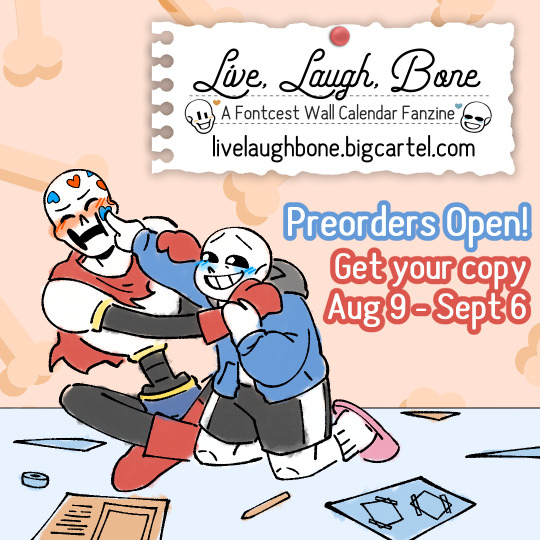
Live, Laugh, Bone: A Fontcest Wall Calendar Fanzine
💙🧡 NOW ON SALE 🧡💙 August 9 - September 6
ORDER HERE: livelaughbone.bigcartel.com
Get your copy of the scrapbook-themed, fontcest wall calendar and stickers!
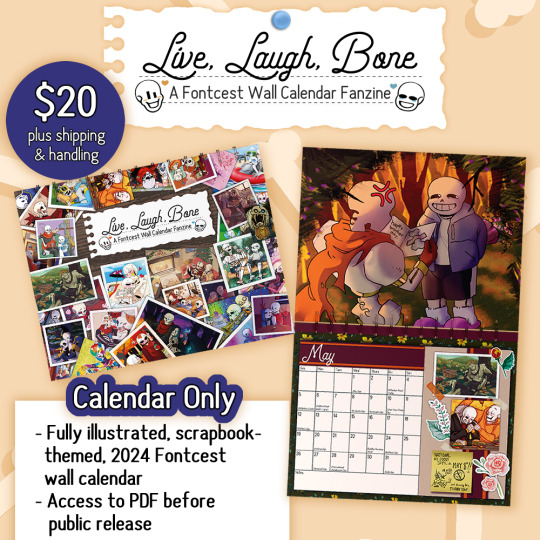


EDIT AUGUST 30: ALL STRETCH GOALS REACHED AND TWO MORE BONUS STRETCH GOALS ADDED:


EDIT SEPTEMBER 6: ALL STRETCH GOALS REACHED
BUNDLE DETAILS BELOW CUT
CALENDAR ONLY OPTION $20 💀 Physical wall calendar 🧡 All 12 months of 2024 (48+ illustrations) 🧡 Art from 20 artists featuring different #Fontcest ships! 🧡 Scrapbook-themed 💀 PDF will be emailed directly before general public release
FULL BUNDLE $28 💀 Physical wall calendar 💀 Early release PDF 💀 Merch 💙 1" Fellcest Die-Cut Sticker by moto 💙 2" Swapcest Die-Cut Sticker by Ray 💙 3.5x2" "emitting SLIME it's just what brothers do" Sticker by Soul 💙 4x6" Outertale Lantern Festival Sticker Sheet (includes 8 stickers) 💙 Qualifies for STRETCH GOALS
STRETCH GOALS FOR FULL BUNDLE ORDERS 🦴 40 Sales* (UNLOCKED) - Fontcest Die-Cut sticker by beetle 🦴 50 Sales* (UNLOCKED) - Spicykustardpuff (Tale x Fell Bros) Die-Cut sticker by Ganzooky 🦴 60 Sales* (UNLOCKED) - Live, Laugh, Bone die-cut magnet by Soul 🦴 70 Sales* (UNLOCKED) - Swapfellredcest Bookmark by Ganzooky 🦴 75 Sales* - Fellcest print and January 2025 Calendar Insert by beetle 🦴 100 Sales* - Xtalecest Die-Cut Sticker by 0netype
* Sales assume "full bundle" sales or equivalent amount in "calendar only" sales
#undertail#fontcest#papysans#sanspapy#papysanspapy#sanspapysans#xtalecest#classiccest#talecest#classic fontcest#honeymustard#fellcest#spicykustardpuff#kedgeup#swapfell red fontcest#underfell fontcest#swapfellredcest#kustard#sanscest#edgepuff#redpuff#swapcest#au fontcest#cross au fontcest#fanzine#proshipper#proshippers please interact#proshipping#proship#please feel free to block if you don't want to see this project or the ship associated with it!
269 notes
·
View notes
Text
Welcome!
In this blog I post my original photos, and the very occasional reblog. All original posts are my work, unless otherwise stated. All reblogs are not my work.
I try to keep all my photos to London and the immediate environs, such as short trips that I start on foot or bike from within London (just so I can include Epping in this). My photos from outside of London may mostly be found at @eternalwandering.
Prior to Easter 2024, I tried to post as close to the time I took the photos as possible, but since then, I've given up, and I've just posted as and when I've felt like it.
I currently use a Canon EOS 50D and an iPhone 11 Pro, but in the past I have also used an iPhone X, an iPhone 6 Plus, and a Moto X Force (Droid Turbo 2 for those of you state-side, although it's pretty unlikely that anyone will know about this phone). My Canon in fact just turned 15, which is an incredible amount of time, and I've done things with it, gone places with it, that were beyond my wildest imaginings when I first got it on my first steps into photography.
I do not currently have a particular visual language, I just take whatever takes my fancy, and then process it mostly at another time with another frame of mind. I do however like the interplay of light and shadows, and what they can do. I'm not fond of shooting people or other moving live creatures, but I do it occasionally.
Lastly, to any porn blogs/spam bots: I respect the hustle, and I think the world would be better with a lot more love (and kinks) in it, so you are welcome to follow my Tumblrs if you wish. On the other hand, if you try to message me and ask me for personal information or anything unrelated to the content of my Tumblr, I'm afraid I will have to report you as spam. So please don't.
PS: If anyone has any good theme recommendations that go well with my photos, I welcome suggestions!
48 notes
·
View notes
Text
Megadeth - Moto Psycho
#Megadeth#Unplugged In Boston#Moto Psycho#Acoustic#2006#Format:#CD#Album#Stereo#Live album#Release date:#Genre:#Thrash Metal (early/later); Heavy Metal/Rock (mid)#Themes:#Society#Politics#History#Death#Religion#New World Order#Addiction#Love#USA
3 notes
·
View notes
Text
Costume Meta 7x03
so there aren't al l that many costumes to talk about this week from a min cast perspective as pretty much everyone is either in uniform, or a costume they've been wearing for the previous two episodes!
I do have a few things to talk about though so I'm still writing this meta and then I'll be gearing myself up for next week when I have a feeling I'll be up to my eyeballs in new costumes!!
Check theory
The danger around Jared played out - he large bold check signalled that he would be in danger - and he met a grim end!
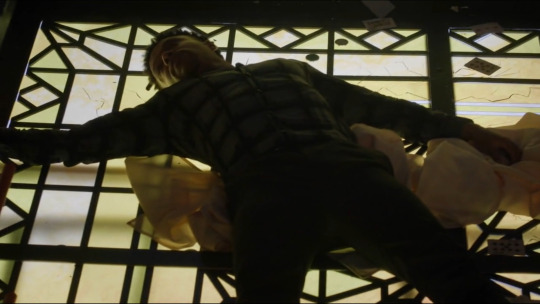
Pink Theory
I feel like I'm spending every episode playing spot the bright pink and this one came to the pink party as well - we have Corey's dad in this pink sweater and then Corey's two siblings in pink.


Its really interesting to me that we're not seeing this bright pink on any of our mains up to this point (Athena has worn pale pink but not bright pink)- its always been on guest cast (Marisol, Lola, Norman, the mom trapped in the car) and there's a fairly even split between the characters who are in one episode and the multi episode arc characters.
I've already pointed this out but the various traits associated with bright magenta/fuchsia pinks are as follows
Things that are considered positive traits for this shade of pink are; intensity, acceptance, kindness and it's supportive and uplifting nature. It's connected to naive love (as in lust rather than the passionate and enduring love of red) can also be considered a nurturing colour.
Negative traits are; intensity, volatility, arrogant and impatient, irritability and irritating and frustration. it is also said to be a stress inducing colour and is said to be overly emotional and childish.
Stripe Theory
Then we have the stripes - Corey (who I'm convinced is autistic but thats maybe just me projecting!!) is in stripes pretty much the entire time.
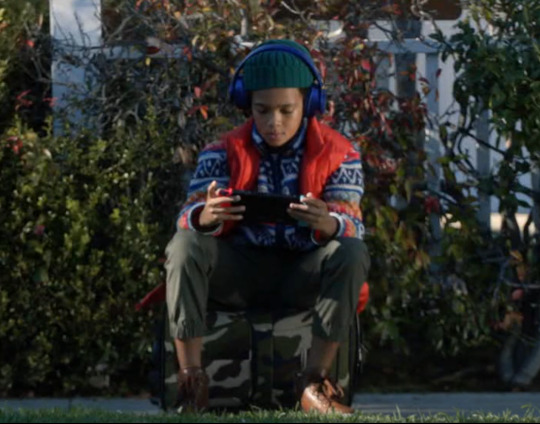
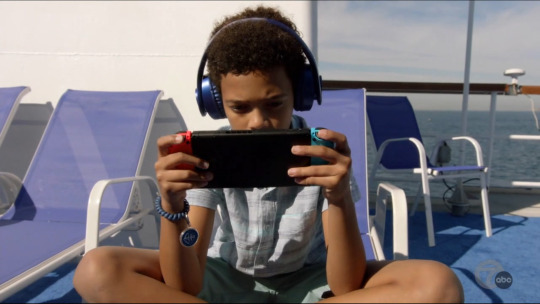
The only exception is when the family is on Manzanillo - when he is wearing a watery themed shirt - again separating him from most of the rest of the family - who are all in floral prints (older brother is all in white and not the floral Hawaiian prints but he and his sister (I think they're meant to be twins?!) switch between who is wearing the bold print and who is in a white top throughout the episode)


Mom wears stripes as well - before she gets onto the ship - we see her in this striped coat. Dad and the sister also wear stripes and check scarves, showing that the entire family is in peril, but the largest amount of stripes are saved for the ones who will be in the most danger - which makes total sense from a pattern theory perspective.

An amusing aside that had me giggling - this top is shear perfection when paired with the 118 deciding their new moto is who cares!!😂
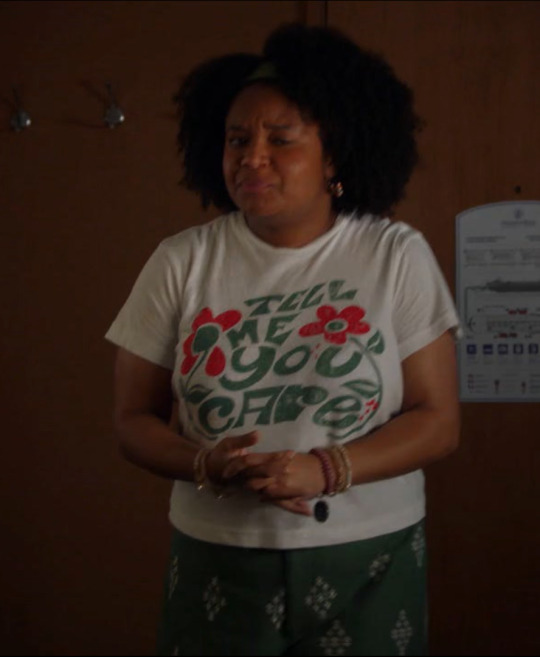
Right off to the firehouse to finish up! - I've mentioned before how uniform variation is used to separate out a character where needed (I wrote about it in my 6x09 meta) so here in the firehouse we have two separations going on - Buck and Eddie are the only ones in t-shirts - separating them from everyone else.
In connection to this separating them from the rest of the firehouse crew is that yellow rag Buck is waving around - it feels a little bit like that red one we saw him with several times in season 6 - the season of red flags.
In the same way t hat red cloth was like a red flag, this reads like a yellow flag - now yellow flags are interesting. In shipping terms they were historically a signal of quarantine (this isn' the case any more), and in sports generally they are used to denote hazardous conditions (motor racing and on beaches relating to surf and currents).
But the more interesting yellow flag concept is the yellow flag in a relationship - generally speaking they are indicators of things that could become problematic and turn into red flags if not dealt with or communicated about (yup communication again). Paired with the fact that Buck and Eddie have been 'singled' out through their uniform, its telling us issues ahead (even if we didn't know about them) and that its their dynamic that is going to be tested and that they are going to need to communicate.
Now all those yellow hoses hanging around in the back ground and then one hose physically connecting them - is certainly a choice (remember they could have used one of the non yellow hoses if it wasn't important) and a pretty loud one. I go on and on about yellow lines of communication, a lot, and I have in my metas for this season so far, but here we have another example of yellow ropes.. lines, cables etc.
The really really key thing here is that we haven't actually seen Buck and Eddie connected by a yellow anything since the end of season 3 and having not seen them connected with a yellow anything since season 3 - when their respective yellow lines got cut/burnt. This one here is about , a yellow line of communication being re-established. What adds to this is the directorial choices - the yellow flag is waves around before they connect themselves with a yellow line (hose) - as a piece of directorial foreshadowing I am in love - its telling us the Buck is the one who is the creator of the yellow flags (read his jealousy) and he is the one with the yellow rag (in the same way he was the one with the red rag previously), but that it will ultimately lead to Buck and Eddie reconnecting after those flags are raised and dealt with. I cannot stress enough the importance of that yellow line between them being reconnected - it really speaks of their communication improving and that we'll see them operating on a level we haven't seen before - they cut their yellow lines at the time when Eddie was changing his will, and whilst they have spoken on important topics etc since then, there has always been something in between them - they haven't had a proper full cards on the table conversation. My feeling is that we might be about to get that (especially combined with what we know from what Oliver and Ryan have teased!)


Then there is Chimney who is separated from everyone else by virtue of being the only one in a long sleeved shirt. If you watch the scene through, and pay attentiion to the background, you'll see all the firefighters in either short sleeve shirts or wearing bomber jackets. there is one exception - a guy carrying a medical bag who I'm pretty sure is meant to be a representaion of Hen's reinstatment to the 118 as he crosses Chim at the time Chim announces Hen has been reinstated!

Thats all from me this week - hope you enjoyed! I'm off to prepare myself for Thursday night!!!
Tagged peeps below!
@theladyyavilee @mistmarauder @xxfiction-is-my-realityxx @mandzuking17 @spotsandsocks @loveyou2thecore @rogerzsteven @wanderingwomanwondering @oneawkwardcookie @leothil @copyninjabuckley @shammers86 @crazyfangirlallert @missmagooglie @katyobsesses @radiation-run @gayandbifiremenofmine @bi-moonlight @crazyaboutotps @princesschez75 @alliaskisthepossibilityoflove @sherlocking-out-loud @tommykinarddd @satashiiwrites
#kym costume meta#911 costume meta#911 meta#911 abc#7x03#season 7#kym colour theory#911 colour theory#911
63 notes
·
View notes